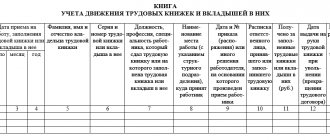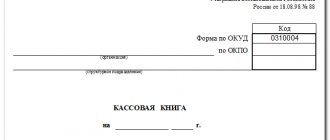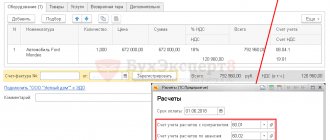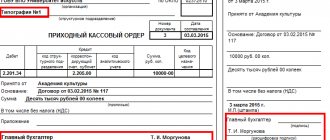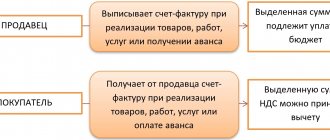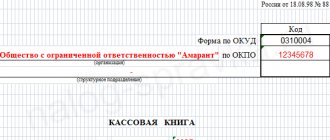How to correct an error in the cash book
The question of the possibility of edits has been resolved, now let’s reproduce the algorithm for making corrections:
Step 1.
You need to cross out the erroneously entered data.
Step 2.
Next to the crossed out erroneous data, enter the correct data. It is very important that they are readable and legible.
Step 3.
We indicate the date the corrections were made.
Step 4.
The signature of the person by whom the corrections were made is affixed, with a transcript.
Corrections must be made by the same employee who originally compiled the document. Since the cash book is maintained by a cashier or accountant (this responsibility is assigned to them by order), it is they who will have to make corrections when errors are detected.
IMPORTANT! If an error is discovered that was made several days ago, and it affects the cash balances, the data of which is transferred to subsequent sheets of the cash book, then all sheets that require such corrections are subject to correction.
The material “Cash Discipline and Responsibility for Violating It” will help you check whether you are making mistakes in cash discipline.
Correction of cash documents when using online cash registers
In a situation in which the type of payment was incorrectly reflected in the cash receipt (not in cash, but by bank card), it will not be enough to return the receipt. If you make such an error, you must print a correction check
The period during which the error was discovered will not be taken into account, as long as it does not extend beyond the period of submission and approval of reporting
In addition, a prerequisite for printing this check will be its execution after the opening of the shift and before its completion. For the rest of the period, the correction check will be invalid.
It is also worth remembering that when generating a correction check for the previous period (day of work), you must indicate the date on it. For which the adjustment is made. So, for example, if the correction check itself is issued for July 14, then a note about the change for July 2 is made in it.
In making adjustments in this way, there is a significant nuance: if an inaccuracy is identified on your own, the code “0” is entered on the check. If an error is detected in the calculations by the tax authorities, the code “1” is assigned, which means that operations are carried out as prescribed.
When choosing the basis for adjustment, you can refer to your current account statement. It must be pinned to the generated check. When considering the adjustment of primary cash documents when using online cash registers, it is worth noting the transparency of such transactions with the tax authorities.
If in the previously discussed adjustments, fiscal service employees may not have noticed the corrections due to the large document flow, then when using online cash registers, all operations are available in real time and require greater care and scrupulousness.
The article discusses the reasons and possibilities for correcting cash documents. By following the above recommendations and timely monitoring of changes in current legislation, you can avoid conflicts with inspection authorities, as well as minimize the likelihood of imposing penalties. Whatever method of conducting cash transactions is chosen by the institution, the basic rule will always be the correct reflection of accounting data.
The specialist in the video will analyze in detail the pitfalls when filling out and maintaining primary accounting documentation, how to conduct electronic document management and much more:
Noticed a mistake? Select it and press Ctrl+Enter to let us know.
Corrections in the cash book: sample
Now let's move on from theory to practice, and, following the instructions we previously presented, we will make changes to the cash book.
Let’s imagine that in the cash book the corresponding account was incorrectly indicated for the amount issued for the account for the consumables. This is what the cash book sheet looked like before the correction:
| Document Number | From whom it was received or to whom it was issued | Corresponding account number, subaccount | Income, rub. cop. | Expense, rub. cop. |
| Balance at the beginning of the day | 10 000 | X | ||
| Orlov K. A. | 3 000 | |||
| Total for the day: | 3 000 | |||
| Finally the rest of the day: | 7 000 | X | ||
Cashier Kulikova D.I.
I checked the entries in the cash book and received documents in the amount of ____-____ receipts and __one__ expenses.
Accountant Tarasova N. G.
And this is what the cash book sheet will look like after correction:
| Document Number | From whom it was received or to whom it was issued | Corresponding account number, subaccount | Income, rub. cop. | Expense, rub. cop. |
| Balance at the beginning of the day | 10 000 | X | ||
| Orlov K. A. | 51 71 | 3 000 | ||
| Total for the day: | 3 000 | |||
| Finally the rest of the day: | 7 000 | X | ||
Cashier Kulikova D.I.
I checked the entries in the cash book and received documents in the amount of ____-____ receipts and __one__ expenses.
Accountant Tarasova N. G.
Corrected believe Cashier Kulikova D.I. 08/23/19
Now you know exactly how to correct the error made in the cash book correctly.
Briefly
- Since 2014, it has become possible to correct errors in the cash book. This applies to registers filled out either by hand or in electronic format with subsequent printing of sheets.
- Electronic cash register books certified with digital signature are not corrected, but a new electronic document is formed.
- The cash book is corrected by the employee who previously entered data into it. Each correction is certified by his signature and the signature of his supervisor. Adjustments are made according to the rules of the Central Bank 3210 U and Federal Law-402.
- Violation of these rules may result in close attention from regulatory authorities, with fines imposed in accordance with Art. 15.1 Code of Administrative Offences.
How to fill out RKO correctly
Important! Today, in cash settlement services, the recipient does not necessarily have to fill out the amount received by hand. It can also be printed on a computer (instructions of the Bank of Russia No. 3210-U dated March 11, 2014).
RKO (expenditure cash order) can be issued either by hand or using special technical means. When filling out the cash register by hand, you can use any color of ink; there are no restrictions in this case. In the “Base” line, the content of the business transaction is indicated, for example, like this: “Reimbursement of overexpenditure according to the advance report dated August 31, 2018 No. 123.” The “Appendix” line should contain a list of attached primary documents (invoices, applications, etc.), indicating their numbers and dates of preparation.
RKO numbering can be done at will, as is convenient for the organization. As a rule, numbering is used in ascending order or using a combination of letters and numbers. Numbering can be continuous or non- continuous. The procedure for maintaining cash documents does not oblige companies to maintain their continuous numbering. There is no liability for violation of order numbering. However, if omissions or duplicate numbers are found, the regulatory authorities may conclude that there may have been unaccounted funds in the cash register. And this in turn will lead to a more thorough check (
Highlights ↑
Previously, all business entities were required to maintain a cash book. The new Directive of the Central Bank of the Russian Federation No. 3211-U allowed individual entrepreneurs not to maintain cash books.
Individual entrepreneurs and small businesses are only required to generate payroll and payroll statements when paying wages and other remunerations in cash to individuals.
For legal entities, maintaining a cash book is still mandatory. At the same time, there is no prohibition on the use of cash documents by individual entrepreneurs.
Legislative amendments mean that inspection authorities do not have the right to check the availability of this documentation and punish for its absence. If it is convenient for an individual entrepreneur to use a cash book, then he can use it to keep cash records.
According to the new Directive, the procedure for maintaining cash documentation now differs between regular and simplified. Individual entrepreneurs and small businesses should maintain documentation in a simple manner.
As for legal entities, except for banking organizations, they are required to apply the usual cash accounting procedure. The forms of standard cash documents have not changed since the entry into force of the new Central Bank Decree.
What it is
When analyzing the term “cash book”, it is worth paying attention to such concepts as cash register and cash register. These definitions are often confused with each other. This makes it difficult to understand what exactly a cash book is.
A cash register or cash register is a device required when accepting cash. That is, when something is sold for cash, an economic entity is required to use a cash register.
In some cases, it is possible to use strict reporting forms instead of cash receipts. The cash register is the totality of absolutely all cash transactions of an entrepreneur.
The cash register displays cash income and expenses. All cash revenue received, including through a cash register or cash register, must be reflected at the cash desk.
Maintaining a cash book is in no way connected with the calculation of tax payments. Even in the absence of cash transactions and cash registers, it is still necessary to maintain a cash register.
For example, expenses do not affect the calculation of tax when applying the simplified tax system or UTII.
A cash book is a document that reflects all income and expense transactions with an entrepreneur's cash.
This document contains information about all deposits from clients, suppliers, funds issued to creditors, contractors, etc.
The Goskomstat resolution approves a unified form for the cash book, which is called KO-4. The book is kept on an accrual basis from the beginning of the year.
At the end of the calendar year, a new cash book is opened. If the book ends before the deadline, it is allowed to start another one and continue keeping records in chronological order.
As a rule, a ready-made book form, produced by printing, is used. It already has the required columns and columns lined up. It is also not prohibited to maintain a cash book in electronic format.
Recommendations for filling
The standard appearance of the cash book makes it easier to fill out. But you still need to comply with some requirements regarding the procedure for drawing up this document.
This is interesting: Existing forms of financial statements in 2019
The main recommendations for filling out are as follows:
| Book title page | Must contain full details of the legal entity or individual entrepreneur. The time interval over which records will be kept is also indicated. |
| One book can be used for no longer than one year | It is strictly forbidden to keep one cash book for several years. |
| All pages of the document must be numbered and bound | The number of sheets must be indicated on the back of the book. |
Maintaining a cash book includes strict execution of this procedure based on six documents:
| Books of accounting of issued/received funds | Which is required to account for cash flow during the day |
| Incoming and outgoing cash orders | How is cash received and issued from the cash register formalized? |
| Cash book | Necessary for collecting information about cash transactions |
| Payroll | Used to record paid wages |
| Payroll | Necessary for recording working hours, deductions and salary payments |
In light of the new adjustments to the procedure for maintaining cash accounting, the following nuances that have arisen can be noted:
| Cash documentation can be maintained in electronic format | Documents are confirmed by electronic signature |
| Second sheet of the cash book (cashier's report) | No need to fill out |
| A general cash receipt order can be created | Both on the basis of the KKM control tape for the day, and on the basis of BSO |
| The recipient no longer has to enter the amount | Cash received in the cash settlement order |
| When issuing cash to an employee, report | It is necessary to draw up an application in any form. This is drawn up indicating the amount, period of use of the issued funds, date and signature of the manager |
| Statement of payment of wages | As before, it assumes that there is a “deposited” entry opposite the employee’s last name. Maintaining a register of deposited funds has become optional |
Normative base
The procedure for conducting cash transactions in the Russian Federation was approved by the Board of Directors of the Central Bank of the Russian Federation in 1993. In accordance with it, the organization's cash book must be numbered, laced and certified with a seal.
When filling out the cash book, each entry in it must be certified by the signatures of the chief accountant and the manager. According to the approved Procedure, the cash book is the main document confirming the receipt and expenditure of cash.
It consists of a list of incoming and outgoing orders for the cash register, having a prescribed form. The book also contains information about the cash balance at the beginning and end of the day.
Warrants are filed with the cashier's report in form KO-3. The totality of the cash book and cashier's reports are the main accounting documents when maintaining an account 50.
Resolution of the State Statistics Committee of the Russian Federation No. 88 dated August 18, 1998 approved special forms of primary documentation.
Here are also examples of forms PKO 0310001, RKO 0310002 and cash book 0310004. The same Resolution determines the maintenance of a book in a single copy.
If a company has structural divisions operating on a separate balance sheet, each one maintains a separate book. Copies of the cash books are sent to the main office.
From June 1, 2014, in accordance with Directive of the Central Bank of the Russian Federation No. 3210-U, the procedure for conducting cash transactions has been changed. The form of the book has been preserved. The changes were reflected in the optionality of maintaining this document for individual entrepreneurs.
Procedure for filling out RKO
The director’s signature on the order is not required if his signature is in the appendices to the RKO. If the company does not have an accountant, then the manager’s signature will be required in any case, even if he has already signed the attachments to the order.
When working with RKO, an organization should have the following procedure:
- The cashier must check the presence of the necessary signatures, the correspondence of the amounts recorded in figures and words, and whether all the documents specified in the cash register are present. In addition, the coincidence of the full name on the document with the data of the presented ID of the recipient is checked.
- You should prepare the required amount of money for the recipient, and also obtain his signature in the cash register.
- The cashier must count the money in front of the recipient so that the recipient can observe his actions. After this, the money is issued to the recipient
- After this, the money is counted by the recipient in the presence of a cashier. If this is not done, then it will no longer be possible to file a claim.
- The last step is the signing of the cash register by the cashier.
How to sew a book?
Before you start maintaining a cash book, you need to calculate the number of sheets required and print them.
Then all pages are numbered. In this case, continuous page numbering is used. The book is laced or stitched using thick threads, then certified with the signatures of the director and chief accountant
It is important that the sheets cannot be removed from the book. To do this, the book is sealed using a wax or mastic seal.
The last sheet indicates the actual number of sheets. In this case, the numbers must be deciphered, that is, written in words. This sheet is also subject to signature by the accountant and director of the enterprise.
There are options when the book is sewn together using threads, and their ends are sealed with paper. In addition, the sheets may stick together. In any case, they must be fastened in such a way that they cannot not only be removed, but also new ones cannot be inserted.
What mistakes are most often made in RKO
If we look at the practice of auditing cash payments, we can conclude that there are quite a lot of violations in this area, including in the preparation of cash documents. The most common violations are the following:
- lines are filled in carelessly when filling out manually, or lines are shifted when filling out a document on a computer;
- RKOs are not numbered;
- there are no corresponding accounts (sub-accounts) in RKO;
- the line “Attachment” does not indicate all the details of the attached documents;
- VAT allocated incorrectly;
- The full names of the persons signing the RKO are entered illegibly, some signatures are missing;
- blots, corrections or erasures were made in the RKO.
Error in cash receipt order: how to fix?
Important! Corrections are not allowed in cash documents. If a mistake is made in the RKO, it should be rewritten.
There should be no corrections in cash documents. The same requirement applies to cash settlement services (Bank of Russia Directive No. 3210-U, clause 4.7).
If an error is discovered, it is no longer possible to correct the RKO. The only option is to compile it again with the correct data.
If the tax authorities discover that there are corrections in a cash document, then this document may be considered missing, which will lead to the company being accused of storing unaccounted revenue. For example, for exceeding the established limit at the cash register. And for this the fine can be up to 50,000 rubles (15.1 Code of Administrative Offenses of the Russian Federation).
When drawing up a new cash register, instead of an incorrect one, the previous order should be crossed out and attached to the cash book. At the same time, it should be indicated in the PKO and RKO registration log that incorrect orders have been cancelled. This entry is made in the notes. In the cash book, you should also cross out the incorrect entry and write down the correct amounts instead of the incorrectly recorded amounts. All corrections in the book must be certified by the signatures of the cashier and the chief accountant.
If the cashier made a mistake in any figures when filling out the cash register, then an explanatory note should be taken from him. In the explanatory note, he must indicate why he made mistakes in the numbering. In this case, disputes with regulatory authorities may be avoided (
Foundation and general order
In the instructions of the Central Bank, paragraph 4.7 is devoted to corrections. It still contains a ban on corrections in the cash book, but it only applies to electronic documents. In this case, “electronic document” means the following procedure for maintaining a book:
- is completely maintained electronically on a PC using special software;
- is closed like a regular “paper” book every day, with the balance of the actual availability of funds being reconciled;
- certified by an electronic signature;
- The head of the company is responsible for the safety of information.
Who is required to maintain a cash book and how to do it ?
Such an electronic document is comparable to a paper one, so there is no need to print it.
On a note! The concept and procedure for using an electronic signature (EDS) is regulated by Federal Law No. 63 dated April 6, 2011.
Maintaining a document on paper allows you to make changes to it if an error is detected. A large number of companies maintain a cash book in the following way: a separate file is opened on the computer, for example, in Excel spreadsheets, and a spreadsheet is built that replicates the form of the document, where the cashier enters data. At the end of the day, he makes a reconciliation, calculates the balance, prints it out and gives it to the accountant, who puts his signature on the document.
How to correct an error identified in the cash book after signing ?
At the end of the year, the cash book printed from electronic format is stitched and certified with a seal. Continuous numbering of sheets is required. Such an electronic book, like a register that is kept by hand, can be corrected because it does not have an electronic signature. The possibility of correction follows from the very concept of a cash book. The instructions prohibit editing cash documents (PKO, RKO), but the book is an accounting register.
Responsibility for incorrectly completed cash register
There is no penalty for filling out the RKO or PKO incorrectly. However, if the document is filled out with errors, the inspection authorities may consider it missing. For example, if there is no decoding of the surname in the RKO, this means that the document was drawn up with violations. The RKO must be signed in such a way that the signature can be used to identify the signatories, that is, those persons who are responsible for processing this transaction.
Important! If there is no transcript of the signature, then the inspection authorities can equate the warrant with missing documents, and this can lead to a fine of 10 thousand rubles (120 Tax Code of the Russian Federation).
This fine may be imposed on the basis that the company’s primary documents are not properly prepared. However, the imposition of such a fine is also unlawful, since it is provided for the fact that documents are missing, and not for the fact that they are executed incorrectly. In this case, the courts may side with the organization.
What, then, can lead to incorrect drafting of RKO? A document executed in violation may cause them to lose their evidentiary value. For example, if in court it will be necessary to prove the fact of issuing cash to a certain person who declares that he did not receive any money.
Basic provisions
The regulation dated October 12, 2011, approved by the Central Bank, establishes the procedure for working with the cash book. According to it, any business entity that directly deals with cash is required to maintain this reporting documentation. If previously individual entrepreneurs (IP) may not have maintained this type of documentation, then the issuance of this resolution obligated them to maintain cash books, regardless of the taxation system.
The document is drawn up according to form KO-4, approved by the State Statistics Committee on August 18, 1998, resolution No. 88.
Start the book at the beginning of the year and fill it out before the beginning of the next calendar year. Then the book is handed over to the archives of the enterprise, where it is stored for 5 years. During this time, the tax service can check it, give comments on maintaining documentation, and even issue a fine.
A company can only have one active cash book. Incorrect maintenance of a document, making mistakes and incorrect corrections, or even failing to do so during verification can lead to fines.
Answers to common questions
Question: Is it possible to fill out part of the RKO by hand, and part on the computer?
Answer: The legislation does not establish a ban on filling out cash registers using a combined method. If it is convenient for the company, then part of the document can be filled out on the computer, and the rest by hand.
Question: In RKO, the corresponding account is indicated incorrectly. How to fix this if the employee signing this document has already quit?
Answer: No changes can be made to the RKO. In this regard, the employee who compiled the RKO must be required to provide an explanatory note, as well as draw up an accounting certificate that will explain the reasons for the discrepancy.
Rate the quality of the article. We want to become better for you: If you have not found the answer to your question, then you can get an answer to your question by calling the numbers ⇓ Free legal advice Moscow, Moscow region call
One-click call St. Petersburg, Leningrad region call: +7 (812) 317-60-16
Call in one click From other regions of the Russian Federation, call
One-click call
> Test task
Enter the site
There is no power of attorney record.An entry about the power of attorney must be made in the cash receipt order if, on its basis, the counterparty’s employee received money. The power of attorney itself must be attached to the order. Otherwise, the operation will not be counted. The basis for depositing money is not filled out.
In the receipt order you need to fill in the basis for depositing money. It is safer to write a clear purpose. For example, return of accountable funds. Otherwise, tax authorities may consider the money as unaccounted revenue. 5. Incorrectly certified cash documents.
All cash documents must be certified by 2 employees: the chief accountant (or ordinary accountant) and the cashier. The expense order is also signed by the manager. It follows from the procedure that the director’s signature is required if the document was not certified by the chief accountant or accountant. But the signature details remain on the form itself, so it’s safer to take a visa from the manager.
II. Cash book.
All companies that handle cash are required to maintain a cash book. Moreover, the document must be in each division of the organization, because a separate office transmits a copy of the book sheet to the company. If there is no register, inspectors will issue a fine for each unit without a book ( letter of the Federal Tax Service of Russia dated August 17, 2017 No. SA-4-20/16322
).
o Commonly made errors in the cash book.
§ Entries are often entered incorrectly.
This may lead to accounting errors. Entries must be made in the book every day. If there were no operations, the book sheet for the day does not need to be completed ( clause 4.6 of Directive No. 3210-U
). Otherwise, list the entries for each expenditure and receipt order.
§ Transaction records are skipped.
All transactions for the day must be entered into the ledger sheet, that is, information from all outgoing and incoming orders. Due to omissions in records, the company will incorrectly calculate the remaining balance.
§ The number of cash documents is recorded incorrectly.
Record the number of cash documents for which information was filled out in the ledger. If the number is incorrect, it will raise questions on the test.
Ø How to correct papers.
The method of correction depends on the document in which you found the error.
| Document | How to fix the error |
| Cash documents. | § Receipt and expense orders refer to cash documents, and it is prohibited to correct them ( clause 4.7 of Directive No. 3210-U ). Therefore, if the company made a mistake, draw up a new document. § An incorrect order must be canceled - crossed out crosswise or diagonally, and the inscription or stamp “Canceled” must be placed. § Do not throw away the damaged document, but attach it to the registers the day before. |
| Cash book. | § Cash registers can be corrected. To do this, cross out the incorrect data, put the correct data, and the date of correction. § Certify the edits with the signatures of the employees who prepared the document, with an explanation of the surname and initials. There are similar rules in the accounting law. It says that the corrections in the primary report are certified by the employee who compiled it ( Part 7, Article 9 of the Federal Law of December 6, 2011 No. 402-FZ ). § If the company did not enter the transaction into the book, this can also be corrected. Complete the sheet with a note. Recalculate the balance at the end of the day and change the number of documents on the basis of which entries were made in the book. § In the free space of the book, put the entry “Believe the Corrected”, date, positions, full names and signatures of the employees who certified the corrections. § The cash book form has space for 4 signatures: chief accountant, accountant, director and cashier. If the company has the only accountant, he signs for the chief accountant and accountant. § Entries in the cash book are always certified by the cashier. The chief accountant or accountant or, if they are not there, the manager checks the book data with the orders and signs ( clause 4.6 of Directive No. 3210-U ). In addition, from the instructions for filling out the standard form, it follows that the total number of sheets of the book is certified by the manager and the chief accountant. § In fact, the book is compiled by the cashier. But if the information in it is incorrect, then it does not correspond to the orders. Therefore, the chief accountant must submit his visa after re-verification. The cashier and the chief accountant must certify the records. |
Important: The company has the right to correct only documents drawn up on paper. It is prohibited to make changes to electronic books, orders and statements after they have been signed.
(clause 4.7 of Directive No. 3210-U).
Therefore, if your document flow is electronic, draw up new copies without errors and re-certify them with an electronic signature.
©2015-2018 poisk-ru.ru All rights belong to their authors. This site does not claim authorship, but provides free use. Copyright Infringement and Personal Data Violation
At what stage of document flow formation should a primary accounting document be drawn up?
1) on the day of the economic event;
2) immediately, no later than the working day following the day of the economic event;
3) immediately at the time of the economic event, and in the absence of such an opportunity, immediately after its completion
Answer: 3 - immediately at the time of the economic event, and in the absence of such an opportunity, immediately after its completion.
According to Art. 9. Federal Law on “Accounting” - the primary accounting document must be drawn up when a fact of economic life is committed, and if this is not possible, immediately after its completion. The person responsible for registration of the fact of economic life ensures the timely transfer of primary accounting documents for registration of the data contained in them in the accounting registers, as well as the reliability of this data. The person entrusted with maintaining accounting records and the person with whom an agreement has been concluded for the provision of accounting services are not responsible for the compliance of primary accounting documents compiled by other persons with accomplished facts of economic life.
Video: Maintaining a cash book using the 1C program
Find out how to correctly create and fill out a book using the 1C program, and avoid mistakes when filling it out and entering data into it. The video tutorial shows the main stages of not only filling out, but also creating a book, and provides explanations on working with the program and the basics of maintaining documentation.
The cash book is one of the most important financial documents in any organization working with cash flow. The cashier, as well as the chief accountant, are responsible for the availability of this documentation and the correctness of its execution. The absence of a cash book or its incorrect maintenance leads to a fine.
Are corrections allowed in cash and bank documents?
1) corrections are allowed in cash documents, but not in bank documents;
2) corrections are allowed in bank documents, but not in cash documents;
3) are not allowed.
Answer: 3 - not allowed.
According to paragraph 16 of the “Order on approval of the regulations on accounting and financial reporting in the Russian Federation”, making corrections to cash and banking documents is not allowed. Corrections can be made to other primary accounting documents only by agreement with the persons who compiled and signed these documents, which must be confirmed by the signatures of the same persons, indicating the date of the corrections.
reporting person valuation of inventories
Thus, in the test work the goals were achieved and the basic concepts were revealed:
accountable persons - employees of the enterprise who have received funds on account for upcoming travel expenses, for payment of office and postal and telegraphic expenses, for expenses associated with the acquisition of material assets (in retail trade, for the purchase of fuels and lubricants and for other economic needs) .
production inventories are a collection of items of labor used in the production process. They participate in the production process once and completely transfer their value to the products produced, work performed or services provided.
Cash documents: types, registration, storage, corrections
According to the legislation of the Russian Federation, enterprises and organizations are required to keep accounting records of all business transactions. To solve this problem, primary documents are used. Confirmation of the fact of cash transactions at the cash desk of the enterprise is also carried out using primary documents.
Corrections in CD
The main rule or requirement for CDs that should be highlighted is the absence of corrections in accounting registers.
The CD should not contain corrections or blots. In practice, it is common for performers to make changes to a document using correction fluids. Such actions are not permitted.
Let's consider the main options for how corrections can be made to cash documents:
- A mistake was made in the PKO or RKO.
It is prohibited to make corrections in any way (manually, crossing out, covering up). The only solution in this case would be to cross out the PKO/RKO with errors and draw up a new one. The spoiled (crossed out) order is added to the cash register report for the day. It is prohibited to carry out the operation of spending or receiving money on the basis of a damaged document.
- An error was made in the Journals or Cash Book.
The use of correction fluid or erasers is prohibited.
Corrections made as follows are allowed:
- an incorrectly entered inscription is crossed out so that the erroneous inscription can then be read;
- Corrections are made above the crossed out inscription by writing the correct amount or text;
- near the corrected document or in the free fields of the document the following inscription is placed: “Corrected” and must be signed by all persons responsible for maintaining and forming the CD;
- signatures are deciphered, and the date of the edit is indicated;
- corrections are made to all copies.
CD storage
The manager organizes and carries out the process, determines storage locations and approves the procedure for the formation and storage of cash documents in the organization. He must ensure such storage conditions that the documents are safe for the entire period established by law.
General requirements regarding storage periods are established in the Federal Law “On Bukh. accounting”, according to which primary documents and CD registers are stored in the archive for at least 5 years. After the expiration of the established period, they can be destroyed, but provided that there are no disputes or ongoing legal proceedings regarding them.
It should be noted that the period of 5 years is counted from the date of creation of the document, but from the date of the reporting year in which they were generated.
Storage can be organized both in the archive at the enterprise and with the involvement of specialized companies. They provide storage on a contractual and paid basis for as many years as you need.
CD storage must be carried out on the basis of the following rules:
- Documents must be stapled on a daily basis. The deadline for stitching is no later than the next working day.
- Inside the stitching, CDs must be selected according to the following order: in ascending order of accounting account numbers. In the sequence, first of all, according to Dt of the account, and then according to Kt.
- All sheets of stitching are subject to numbering.
- When transferred to the archive, an inventory is generated indicating the quantity and name of the CD stitching; an article can be entered in accordance with the nomenclature approved by the organization.
